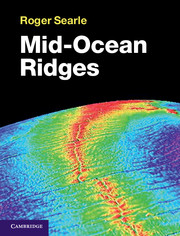Book contents
- Frontmatter
- Dedication
- Contents
- Preface
- 1 Introduction
- 2 Techniques of MOR study: a brief historical review
- 3 The oceanic lithosphere
- 4 Ridges as plate boundaries
- 5 Crustal structure and composition
- 6 Volcanism
- 7 Tectonism
- 8 Hydrothermal processes
- 9 Summary and synthesis
- Appendix A Glossary of terms
- Appendix B Directory of named features
- References
- Index
- Plate Section
6 - Volcanism
Published online by Cambridge University Press: 05 June 2014
- Frontmatter
- Dedication
- Contents
- Preface
- 1 Introduction
- 2 Techniques of MOR study: a brief historical review
- 3 The oceanic lithosphere
- 4 Ridges as plate boundaries
- 5 Crustal structure and composition
- 6 Volcanism
- 7 Tectonism
- 8 Hydrothermal processes
- 9 Summary and synthesis
- Appendix A Glossary of terms
- Appendix B Directory of named features
- References
- Index
- Plate Section
Summary
Introduction
Much of the oceanic crust is built from the products of mantle melting. Approximately 20 km3 of melt are produced per year around the 65 000 km long global ridge system, creating some 3 km2 of new crust with an average thickness of about 7 km. As the lithospheric plates separate at a ridge, plastic asthenospheric mantle is drawn up and rises adiabatically, i.e. too fast to allow for significant conductive cooling. Thus the geotherm under the ridge is raised until it intersects the solidus, when partial melting begins. (Alternatively, one may think of the melting point for a batch of mantle being progressively reduced as the pressure falls.) Once melt has been produced it rises buoyantly, eventually accumulating in or below the crust. From there some melt may erupt onto the sea floor, while the residue cools and solidifies to form the gabbroic lower crust (Chapter 5). Mantle melting was reviewed by Langmuir et al. (1992).
Mantle melting
Most ridges are not situated directly above hot, rising columns of convecting mantle; their positions are largely uncorrelated with the underlying mantle convection (McKenzie, 1967; McKenzie and Bickle, 1988). This means that ductile asthenosphere of normal mantle temperature is drawn up passively by the separating plates at ridges (Cann, 1970; Figure 6.1). This model successfully predicts both the thickness and composition of the oceanic crust (McKenzie and Bickle, 1988).
Information
- Type
- Chapter
- Information
- Mid-Ocean Ridges , pp. 129 - 162Publisher: Cambridge University PressPrint publication year: 2013
